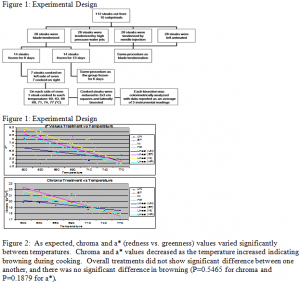Amanda Nordquist and Maria Carter with Drs. Frost Steele and Laura Jefferies, Nutrition, Dietetics, and Food Science
The objective of this study was to investigate the effect of mechanical tenderization on the internal cooked color of beef steak, and specifically to determine if it exhibits premature browning during cooking because of the mechanical tenderization. The microbiological safety of mechanically tenderized meat has been questioned due to its implication in six recent outbreaks of E. coli O157:H7. Current research suggests that tenderization may increase the risk of internal penetration and cross-contamination of E. coli. Consumer evaluation of prematurely browned meat would lead to undercooking; increasing the risks associated with consuming contaminated meat. In this study, beef steaks were mechanically tenderized by either blade tenderization (BT), high pressure liquid jets (HP), needle injection (NI), or left as an untreated control (UN). The methodology used in this experiment is outlined below (Figure 1).
Mechanically tenderized meat is utilized in over ninety percent of restaurant and food store industries and affects virtually all meat consumers. Observations made during Laura Jefferies’ (2009) research indicate that there may be a possibility that mechanically tenderized steaks exhibit premature browning when they are cooked to different temperatures of doneness. This can be defined as the development of an internal ‘well-done’ color when the meat has not yet reached the temperature needed to ensure safety (Sawyer et al. 2008). Internal cooked color (ICC) is typically associated with the degree of ‘doneness’ and there may be a potential risk that mechanically tenderized steaks could show premature browning because of internal exposure to oxygen (Ryan, 2006).
Our results under these experimental conditions demonstrate that mechanical tenderization of beef steaks does not result in premature browning during cooking. We therefore conclude that tenderized beef steak does not seem to present an increased microbial risk to consumers due to premature browning. The lack of a significant relationship between tenderization methods (blade tenderization, high pressure liquid jets, and needle injection) and ICC indicates that there are likely other factors which caused the visual difference in tissue color that initiated this study. These results are summarized in two graphs below (Figure 2).
Based on observations made after the experiment was completed, if additional research were to be conducted, a smaller time restriction for color analysis after cooking should be used in order to verify the results. Also, the research was done on two different days and if the experiment was to be conducted again it would be better to perform it all in one day to help minimize variance.
We were able to put this research into a poster and present it at the annual conference for the Institute of Food Technology, in June 2009.
References
Jefferies L, Steele F, Hansen C. 2009. Microbiological characteristics, cooking requirements, and sensory acceptance of beef eye of round subprimals treated with high pressure injection. Unpublished research.
Ryan SM, Seyfert M, Hunt MC, Mancini RA. 2006. Influence of cooking rate, endpoint temperature, post-cook hold time, and myoglobin redox state on internal color development of cooked ground beef patties. J Food Sci 71(3):C216-21.
Sawyer JT, Apple JK, Johnson ZB. 2008. The impact of lactic acid concentration and sodium chloride on pH, water-holding capacity, and cooked color of injection-enhanced dark-cutting beef. Meat Sci 79(2):317-25.

